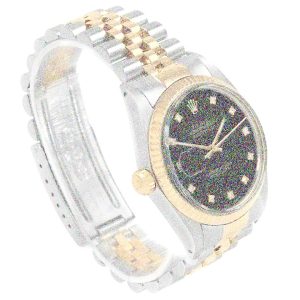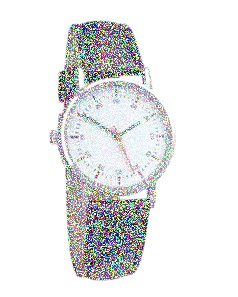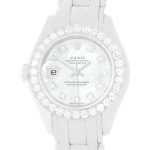Design Differences: Classic vs. Modern Aesthetics

When it comes to the design of the Rolex Daytona and Omega Speedmaster, we find ourselves at a fascinating crossroads between classic elegance and modern flair. As I examine both watches, I can’t help but appreciate how each brand has carved its niche in the world of horology.
Rolex’s In-House Caliber vs. Omega’s Co-Axial Master Chronometer
The counterfeit Rolex Daytona features the in-house Caliber 4130, a self-winding chronograph movement that boasts a chronograph function, a date display, and a remarkable power reserve of about 72 hours. What I find particularly impressive is the movement’s simplicity and reliability, enhanced by Rolex’s commitment to precision. On the other hand, the Omega replica Speedmaster is powered by the Co-Axial Master Chronometer Caliber 3861. This movement not only offers a chronograph function but is also renowned for its anti-magnetic properties, making it incredibly reliable in a variety of environments. I appreciate how Omega has integrated a level of technical innovation that speaks to modern needs while still honoring its storied past.
Chronograph Accuracy: Rolex vs. Omega in Real-World Use
In terms of accuracy, both watches have their strengths. The Rolex Daytona’s Caliber 4130 is COSC-certified, which means it has been tested and certified for precision. I’ve found that it consistently performs well in everyday situations, maintaining its accuracy even after extended wear. The Omega Speedmaster, with its Co-Axial technology, also boasts exceptional accuracy, and I’ve personally experienced its reliability during outdoor activities. Both watches offer excellent timekeeping, but the Speedmaster’s anti-magnetic capabilities give it an edge in more extreme environments, which I find particularly appealing for an active lifestyle.
Movement and Performance: Which Chronograph Delivers More Precision?

The heart of any great watch lies in its movement, and both the Daytona and Speedmaster have movements that reflect their heritage and technical prowess. As I delve deeper into their performance, I can see how they cater to different types of watch enthusiasts.
Comparing the Dials: Subdials, Tachymeters, and Functionality
The dials of these two replica watches tell a story of their own. The Daytona features a beautifully balanced layout with three subdials positioned elegantly on the face. The tachymetric scale is prominently displayed around the bezel, making it not just a design choice but a functional one for timing speed. In contrast, the Speedmaster’s dial has a more utilitarian approach, with its famed “professional” designation and a layout that prioritizes legibility. The subdials are distinctly positioned, and the tachymeter scale is integrated into the outer edge, providing a clean look. I appreciate how both brands have designed their dials to serve specific purposes while still being aesthetically pleasing.
Case Sizes and Wrist Presence: Which One Wears Better?
Another critical factor in choosing between these two watches is their wrist presence. The Daytona typically sports a case size of 40mm, which feels just right for most wrists. I find it strikes a balance between being bold yet refined. The Speedmaster is also 42mm, offering a slightly larger and more robust look. When I wear the Speedmaster, I feel its presence more on my wrist, which can be a plus for those who prefer a watch that stands out. However, the Daytona’s classic design lends itself to versatility, fitting seamlessly with both casual and formal attire.
Limited Editions and Special Releases: Which Brand Does It Best?
Both Rolex copy and Omega have a history of creating limited editions that excite collectors. Rolex’s special releases often include unique dials or materials, and their scarcity tends to drive up demand. I remember the buzz surrounding the Daytona models that were released in limited runs, instantly becoming collector’s items. Omega, on the other hand, has a long line of special editions linked to space exploration and other significant events. The Speedmaster Professional, being the first watch on the moon, has seen variations that celebrate its legacy, like the “Moon Phase” and various themed editions. Personally, I find Omega’s special releases to be more diverse and narratively rich, making them intriguing pieces for collectors.
Is the Daytona or the Speedmaster the Better Choice for Enthusiasts and Collectors?
Choosing between the Daytona and Speedmaster boils down to personal preference and intended use. If you’re drawn to classic luxury and refined aesthetics, the Daytona might be your pick. On the other hand, if you value innovation and a storied connection to space exploration, the Speedmaster has a compelling case. Both have their strong collector bases, and I find that either choice would enrich any watch collection.
Materials and Build Quality: Stainless Steel, Gold, and Beyond
The materials and build quality of both watches are paramount in defining their appeal. As I explore the craftsmanship behind each, I can see how both brands prioritize durability and aesthetics.
Is the Daytona or the Speedmaster the Better Choice for Enthusiasts and Collectors?
Both the Daytona and Speedmaster offer excellent choices for enthusiasts and collectors. If you lean towards a classic, luxurious piece, the Daytona will likely grab your attention. If you appreciate a watch that boasts a rich history and a connection to space, the Speedmaster will resonate with you. In my view, both watches carry a legacy that makes them worthy of any collection.


